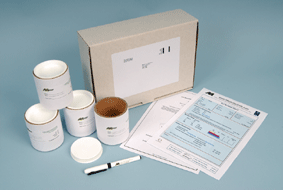How to take a soil sample
 Kit contents
Kit contents
- Indelible pen
- Plastic bag(s)
- Return address label
- Sample container(s)
- Soil sampling instruction sheet
Agricultural sampling
sampling
A soil analysis is only as good as the soil sample from which it is taken.
Each sample should be a composite of 10-20 sub-samples taken at random across the field. The sub-samples are placed in the supplied plastic bag, mixed thoroughly by hand, before filling the cardboard sample container. To keep your sample as representative of the field as possible avoid field gates, water troughs, feed rings etc. It is often useful to walk across the field in a ‘W’ pattern to aid sampling.
 ‘W’ pattern field sampling
‘W’ pattern field sampling
- Write the field name on the sample container and tick the boxes for the analysis requested.
- Take a representative soil sample from the field.
- Return your samples using the pre-paid address label.
Download these instructions.
Garden sampling
Each sample should be a composite of 5-10 sub-samples taken at random across the garden. The sub-samples are placed in the supplied plastic bag, mixed thoroughly by hand, before filling the cardboard sample container. To keep your sample as representative of the garden as possible avoid gates, water feature runoffs, under bird feeders, compost heaps etc. It is often useful to walk across the garden in a ‘W’ pattern to aid sampling. When sampling specific features, for example, flower beds or rockeries, similar care must be taken to ensure a representative sample is provided.
Where the garden consists of a grass area and flower bed, it might be better to submit two samples, as the optimum growing conditions can be very different depending on your planting regime.

'W' pattern garden sampling
- Write the sample name on the sample container and tick the boxes for the analysis requested.
- Take a representative sample from the garden.
- Return your samples using the pre-paid address label.


